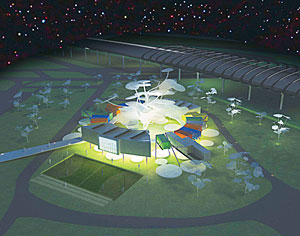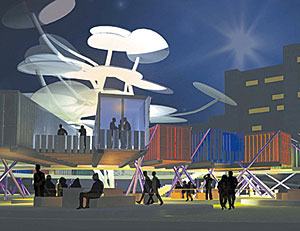RECORD invites designers to redefine the refugee experience.
PHOOEY Architects
Flemington Youth Center
In October 2007, Australia’s then minister of immigration, Kevin Andrews, admitted that the government had altered its refugee policy in response to the impression that Africans, and particularly Sudanese asylum-seekers, had trouble assimilating with the culture. In the wake of the murder of Sudanese refugee Liep Gony, Andrews said, “I have been concerned that some groups don’t seem to be settling and adjusting into the Australian way of life as quickly as we would hope, and therefore it makes sense to put the extra money into slow[ing] down the rate of intake from countries such as Sudan.” Africa’s portion of the country’s annual 13,000-personal refugee allocation had been slashed from 70 percent to just 30 percent in two years.


PHOOEY Architects principal Peter Ho denounces the insensitivity of Andrews’s remarks, but recognizes the complexity of refugee identity. “If given the opportunity to create a new life in a different place, it is likely I would bring my own baggage to the process,” he says. PHOOEY’s concept for a youth center in the Melbourne suburb of Flemington would be both a refuge from the pressures of assimilation and a facility for cultural adaptation.
The design is informed by Skinners Playground, PHOOEY’s year-old activity center for children living in public housing in South Melbourne. Both are fabricated from old shipping containers, but Ho notes important differences between them. The intended users of the Flemington design, for example, are teenagers and young adults who require services with far more breadth and depth than what young children demand. So whereas Skinners Playground comprises four containers linked in an imaginative series, Flemington’s shipping containers are raised on pilotis and arranged in a circle: At grade, Sudanese-Australians can congregate outdoors as they had traditionally, while volumes above are devoted to compartmentalized functions such as athletics, job training, and meal preparation. The cooking courses are a vital component of the scheme, Ho says. “There is no discrimination with food. It celebrates family heritage and cultural diversity.”
Although the youth center should attract crowds, the structure itself treads lightly on the city. Rainwater cisterns as well as photovoltaic and solar hot water panels minimize resource consumption, the site plan preserves existing trees, and film screenings on the exterior of one shipping container offer an amenity to the wider neighborhood. “The facility takes a good-neighbor approach,” Ho notes. “It is a place that breaks down the stigma that local public housing is separate and foreign, and invites all members of the community to be part of it.”

Post a comment to this article
Report Abusive Comment